Header image from National Park Service.gov, Kalaupapa National Historic Park, Hawai’i
Hawaii joined the union on August 21, 1959 as the 50th State
Hawaiin Goose, or Nene
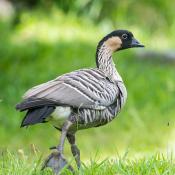
The nene is the world’s rarest goose. It is believed that it was once common, with approximately 25,000 Hawaiian geese living in Hawaii when Captain James Cook arrived in 1778. Hunting and introduced predators, such as small Asian mongooses, pigs, and cats, reduced the population to 30 birds by 1952. The species breeds well in captivity, and has been successfully re-introduced. In 2004, it was estimated that there were 800 birds in the wild, as well as 1,000 in wildfowl collections and zoos.
The nene is a herbivore that will either graze or browse, depending on the availability of vegetation. Food items include the leaves, seeds, fruit, and flowers of grasses and shrubs.
Flower: Yellow Hibiscus
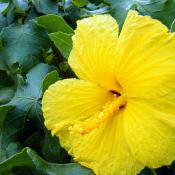
Yellow hibiscus is found only in Hawaii – it grows on all the main Hawaiian islands, but it’s extremely rare (so few remain in the wild, that it’s considered an endangered species). Hawaii changed its state flower from the native red hibiscus (Hibiscus kokio),on June 6, 1988, to the Hawaiian hibiscus – ma’o hau hele, the only species of yellow hibiscus. The flower is edible and has a tangy citrusy taste. It is a popular natural diuretic. Study shows consuming hibiscus tea lowers blood pressure. Traditionally Tahitian and Hawaiian women can wear a single hibiscus flower behind her right ear to let people know she is available for marriage. If the flower is worn behind the left ear, the woman is married or in a relationship.
Tree: Candlenut Tree
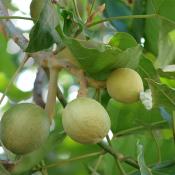
A flowering tree also called the kukui tree. The nut is often used cooked in Indonesian and Malaysian cuisine, where it is called kemiri in Indonesian or buah keras in Malay. On the island of Java in Indonesia, it is used to make a thick sauce that is eaten with vegetables and rice. In ancient Hawaiʻi, kukui nuts were burned to provide light. The nuts were strung in a row on a palm leaf midrib, lit on one end, and burned one by one every 15 minutes or so. This led to their use as a measure of time. Hawaiians also extracted the oil from the nut and burned it in a stone oil lamp called a kukui hele po (light, darkness goes) with a wick made of kapa cloth. Because the seeds contain saponin and phorbol, they are mildly toxic when raw. In Maui, the kukui is a symbol of enlightenment, protection, and peace.
State Quarter
From theus50.com
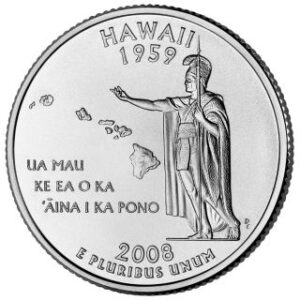
Hawaii, spelled “Hawai’i” in the Hawaiian language, is nicknamed “The Aloha State.” It became the 50th state admitted to the Union on August 21, 1959.
The reverse of Hawaii’s quarter features Hawaiian monarch King Kamehameha I stretching his hand toward the eight major Hawaiian Islands. Inscriptions are the state motto “UA MAU KE EA O KA ‘ĀINA I KA PONO,” (“The life of the land is perpetuated in righteousness”), “Hawaii” and “1959.”
King Kamehameha I is a revered figure in Hawaiian history. He unified the governance of the Hawaiian Islands into one kingdom in the early 1800s and navigated changes in Hawaii, while maintaining the native practices and traditional ways of island life. His “Law of the Splintered Paddle” guaranteed the protection of citizens from harm during war and became a landmark in humanitarian law. He is honored with a statue in the U.S. Capitol’s National Statuary Hall.
Capital: Honolulu
Nickname: Aloha State/ Paradise of the Pacific
Motto: The life of the land is perpetuated in righteousness
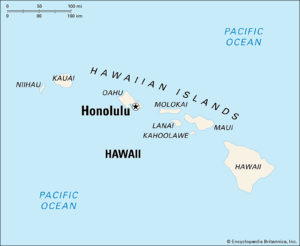 The state of Hawaii consists of eight main islands: Niihau, Kauai, Oahu, Maui, Molokai, Lanai, Kahoolawe and the Big Island of Hawaii.
The state of Hawaii consists of eight main islands: Niihau, Kauai, Oahu, Maui, Molokai, Lanai, Kahoolawe and the Big Island of Hawaii.
Hawaii Facts and Trivia
Under-sea volcanoes that erupted thousands of years ago formed the islands of Hawaii.
The first people to arrive at the Hawaiian Islands were the Polynesians. They travelled to Hawaii by canoe around 500 AD. These original peoples farmed the land and fished for food. Each settlement was ruled by a chief called the ali’i. There were many strict rules called “kapu” that the people lived by and the chief’s word was law.
The first recorded visit to Hawaii by a European was by British explorer Captain James Cook in 1778. At first, the local inhabitants treated Cook as if he was a god. They brought him and his crew many gifts. Cook named the islands the Sandwich Islands after the Earl of Sandwich. In a later visit to the islands, Cook’s crew got into a fight with the local natives and Cook was killed.
For much of the history of Hawaii, each island was ruled by a different chief. In the late 1700s, one chief, Chief Kamehameha, began to rise to power. One by one he took over each of the islands. By 1810, he had taken control of all the islands and became the first Hawaiian king.
Cattle were introduced to Hawaii in 1793.
In 1820, Christian missionaries arrived in Hawaii. They opened schools and taught the Hawaiians how to speak English. They also created an alphabet for the Hawaiian language which had never been written down before.
About the same time the missionaries arrived, so did whalers. The whalers hunted for whales in the waters around the islands. For the next fifty years, whaling ships came to Hawaii. They brought money, new ideas, and disease. Many of the Hawaiians died from the new diseases brought by the Europeans. Also, many Hawaiian traditions, including the kapu law came to an end during this time.
In the mid-1800s, the main industry in Hawaii was farming sugarcane. Many people moved to Hawaii from places like China and Japan to work the sugarcane fields. Many businesses from the United States became involved in the sugarcane industry and soon the Kingdom of Hawaii and the United States had established close ties and trade treaties.
In 1893, the Kingdom of Hawaii was overthrown and the Republic of Hawaii was established. A few years later, in 1898, Hawaii became a territory of the United States. Over the next several years the United States would built military bases on the islands including Pearl Harbor.
1901 – James Dole established the Hawaiian Pineapple Company.
1935 – Amelia Earhart is the first pilot to fly solo from Hawaii to the mainland U.S.
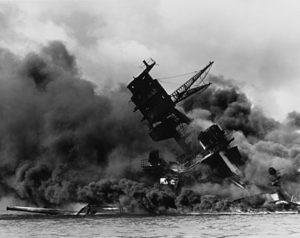 When World War II began, the United States did not join in the fighting. The hope was that the U.S. could stay out of the war. However, on December 7, 1941, the Japanese attacked the U.S. naval base at Pearl Harbor. Many U.S. ships were sunk including the USS Arizona and around 2,500 people were killed. The attack came as a complete surprise to the American people. The U.S. then entered the war and helped to defeat the Axis powers including Germany and Japan.
When World War II began, the United States did not join in the fighting. The hope was that the U.S. could stay out of the war. However, on December 7, 1941, the Japanese attacked the U.S. naval base at Pearl Harbor. Many U.S. ships were sunk including the USS Arizona and around 2,500 people were killed. The attack came as a complete surprise to the American people. The U.S. then entered the war and helped to defeat the Axis powers including Germany and Japan.
After World War II, many people began to want Hawaii to become a state. It took several years, but on August 21, 1959 Hawaii was admitted to the Union as the 50th state.
Hawaii is the most isolated population center on the face of the earth. Hawaii is 2,390 miles from California; 3,850 miles from Japan; 4,900 miles from China; and 5,280 miles from the Philippines.
Hawaii is the only state that grows coffee.
More than one-third of the world’s commercial supply of pineapples comes from Hawaii.
There are only 12 letters in the Hawaiian alphabet.Vowels: A, E, I, O, U Consonants: H, K, L, M, N, P, W
From east to west Hawaii is the widest state in the United States.
The Hawaiian Islands are the projecting tops of the biggest mountain range in the world.
Honolulu’s zenith star, (the star that rises directly above it) is Arcturus. The Hawaiians called it Hokule’a. (Hoe koo lay uh.)
The Hawaiian Archipelago consists of over 130 scattered points of land stretching some 1,600 miles in length from the Kure Atoll in the north to the Island of Hawaii in the south.
Hawaii has its own time zone (Hawaiian Standard Time.) There is no daylight savings time.) The time runs two hours behind Pacific Standard Time and five hours behind Eastern Standard Time.
All subterranean minerals belong to the state. Except for state owned water, some lava stone, and minor granites and semi-precious minerals, there are few underground minerals.
The wind blows east to west in Hawaii. The highest recorded temperature is 96′ F (Honolulu Airport), but temperatures over 92′ F generally occur only once or twice a year. The lowest temperature (under 3000 feet altitude) is 56′ F. Temperatures under 60′ F may occur but rarely more than once a year. Average daytime temp. (July) is 82′ F. Average daytime temperature in January is 72′ F.
There are no racial or ethnic majorities in Hawaii. Everyone is a minority. Caucasians (Haoles) constitute about 34%; Japanese-American about 32%; Filipino-American about 16% and Chinese-American about 5%. It is very difficult to determine racial identification as most of the population has some mixture of ethnicities.
The Islands of Hawaii
Each of the Hawaiian Islands has a flower and color which represent it and which are usually included in the leis of that island.
Niihau Pupu Shell – White
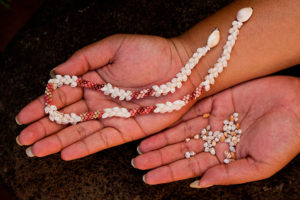 A privately owned island, with livestock raising as its principal industry. There is highly limited access by general public through helicopter landings at uninhabited sites. Legend says Niihau was the original home of the goddess Pele. The island has a population of 230, and is 69 square miles.
A privately owned island, with livestock raising as its principal industry. There is highly limited access by general public through helicopter landings at uninhabited sites. Legend says Niihau was the original home of the goddess Pele. The island has a population of 230, and is 69 square miles.
Kauai – Mokihana (Green Berry) – Purple
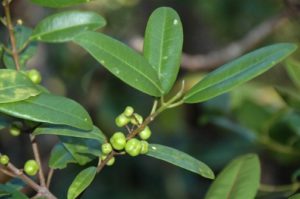 Kauai’s flower actually isn’t a flower at all: The mokihana (Pelea anisata) is a green berry grown only on the slopes of Mount Waialelae. Strung like beads and woven with strands of maile, these hardy berries have a scent of anise.
Kauai’s flower actually isn’t a flower at all: The mokihana (Pelea anisata) is a green berry grown only on the slopes of Mount Waialelae. Strung like beads and woven with strands of maile, these hardy berries have a scent of anise.
Kauai is the fourth largest of the Hawaiian Islands.
The Waialua River is one of five navigable river in Hawaii. It drains off Waialeale Mountain, which averages 488 inches of rain per year and is considered the wettest spot on earth.
The Waimea, the Hanape’pe, the Lumahai and the Hanalei River are almost as big and quite navigable. The Hanalei River was dedicated a “national treasure” recently and is under government protection from use as a “place of business”.
Oahu – Ilima -Yellow
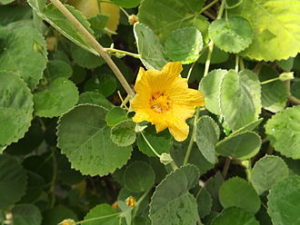
Honolulu is the largest city in the world — at least it has the longest borders. According to the state constitution any island (or islet) not named as belonging to a county belongs to Honolulu. This makes all islands within the Hawaiian Archipelago, that stretch to Midway Island (1,500 miles northwest of Hawaii) part of Honolulu. Honolulu is about 1,500 miles long or more distance than halfway across the 48 contiguous states.
Honolulu is the nation’s 11th largest metropolitan area.
More than 100 world-renowned beaches ring Honolulu.
Iolani Palace is the only royal palace in the United States.
The world’s largest wind generator is on the island of Oahu. The windmill has two blades 400 feet long on the top of a tower twenty stories high.
The island of Oahu draws more visitors than any other to Hawaii. One-third of the state’s best surfing beaches are on Oahu.
Maui – Lokelani (Pink Cottage Rose) – Pink
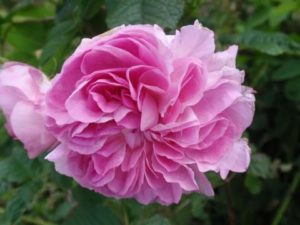
The island is home to many famous attractions including Haleakala Crater, the old whaling town of Lahaina, the road to Hana, and Kaanapali Beach.
Haleakala Crater (Ha-lay-ah-ja-lah), is the world’s largest dormant volcano.
Molokai – White Kukui Blossom – Green
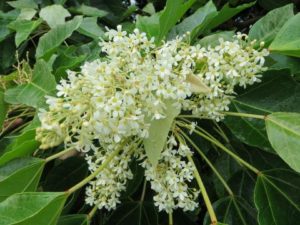
Molokai is known as the most Hawaiian Isle.
Molokai’s east end is a tropical rain forest and part of the island receives 240 inches of rainfall a year.
Molokai Ranch Wildlife Park is home to rare African and Indian animals.
Kalaaupapa was once a leper colony administered by Father Damien.
The island contains the world’s highest sea cliffs, Hawaii’s longest waterfall, and the largest white sand beach in the state.
Lanai – Kaunaoa (Yellow and Orange Air Plant) – Orange

The island of Lanai is considered Hawaii’s most secluded.
The island was once the home of the world’s largest pineapple plantations.
Hulope Bay is a marine preserve and considered one of the best diving spots in the world.
Kahoolawe – Hinahina (Beach Heliotrope) – Grey
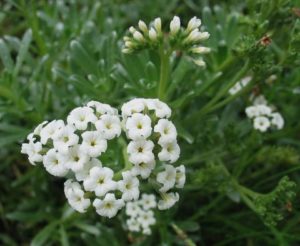
Once used as a target by the U.S. Navy and Air Force the services are cleaning up unexploded shells. No one is allowed to go ashore without permission. The island consists of an uninhabited area of 45 square miles.
Hawaii – Lehua Ohia – Red
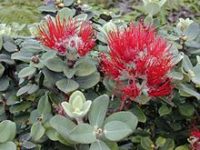
The Big Island is Hawaii’s largest at 4,038 square miles. It is twice the size of all other Hawaiian Islands combined.
The largest contiguous ranch, in the United States, is in Hawaii. The Parker Ranch near Kamuela has about 480,000 acres of land.
At 800,000 years the Big Island is the youngest of the island chain. However, it was the first island discovered by voyaging Polynesians.
Kilauea volcano is the world’s most active.
Ka Lae is the southernmost point in the United States. It is located at 18:54:49 N 155:41:00 W. There is a constant 27 knots per hour wind blowing east to west, 24 hours per day and 365 days per year.
Two of the tallest mountains in the Pacific – Mauna Kea and Mauna Loa – dominate the center of the island.
Kilauea Iki is the world’s most active and largest volcano.
Mauna Kea is the tallest mountain in the world (measured from its base at the ocean floor).
The island houses the world’s biggest telescope and more scientific observatories in one place than anywhere else in the world.
The island is the worldwide leader in harvesting macadamia nuts and orchids.
*******************
Since gaining statehood and participating in its first election in 1960, Hawaii has supported Democrats in all but two presidential elections; 1972 and 1984, both of which were landslide reelection victories for Republicans Richard Nixon and Ronald Reagan respectively. In Hawaii’s statehood tenure, only Minnesota has supported Republican candidates fewer times in presidential elections. The 2016 Cook Partisan Voting Index ranks Hawaii as the most heavily Democratic state in the nation.
In 2016, Hillary Clinton won Hawaii with 62 percent of the vote, according to NBC News results, while Donald Trump received 30 percent. In 2020, Joe Biden garnered 63.7% of the vote to Donald Trump’s 34.3%.
Strange Laws:
Billboards are outlawed.
An individual may only have one alcoholic drink in front of them at any given time.
In Hawaii, you might be fined for riding in the back seat of a vehicle with no seat belt, however, if all seats are already occupied, you can ride in the bed of a pickup truck – with no safety equipment – without being punished.
It is illegal to annoy birds while visiting a state park.
It is unlawful to hoard more than 15 dogs and cats in a home.
By law, twins are not permitted to work for the same company.
You could be fined for not owning a boat.
in 2015 Hawaii became the first state in the U.S. to ban the distribution of single-use plastic bags.
Honolulu City & County’s mayor signed a bill that bans the use of tobacco products, including e-cigarettes, in a car where a keiki (child) is present.
Honu (green sea turtles) attract hundreds of visitors to Oahu’s north shore daily, and while they are beautiful and gentle creatures, please keep your distance. In Hawaii, it is illegal to touch, pick up, disturb, kill, or harm any type of sea turtle thanks to its status as an endangered species. Harming a sea turtle can result in a fine of up to $25,000 and time in prison.
Not only can you not talk or text on the phone while you’re driving in Hawaii, it is now illegal to text and walk in a marked crosswalk. In October 2017, Hawaii became the first state to make it illegal to text or look down at your phone while crossing the street — even in a marked crosswalk.
People:
- Father Damien, leper-colony worker
- Lauren Graham, actress, writer
- Bethany Hamilton, professional surfer who lost an arm to a 2003 shark attack
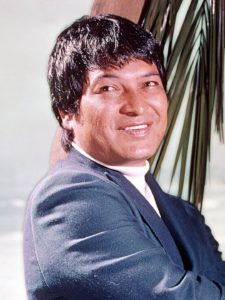 Don Ho, entertainer
Don Ho, entertainer- Jack Johnson, entertainer
- Nicole Kidman, actress
- Lois Lowry, author of children’s books
- Marcus Mariota, football player for Tennessee Titans
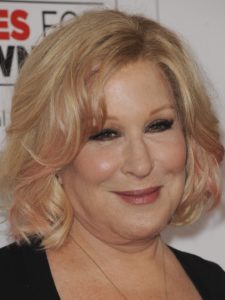 Bette Midler, actress, singer
Bette Midler, actress, singer- Jason Momoa, actor, model
- “Bruno Mars”, Peter Hernandez, singer
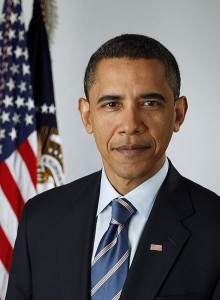 Barack Obama, U. S. President
Barack Obama, U. S. President- Manti Te’o, football player for San Diego Chargers
Credits:
See ducksters
See 50 states.com
See only in your state.com
See when in your state.com
See roberts hawaii.com
